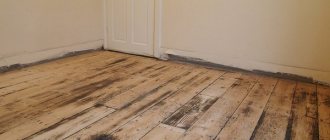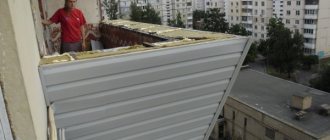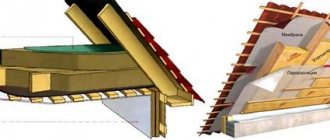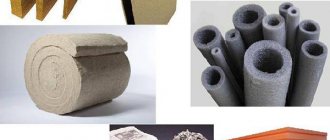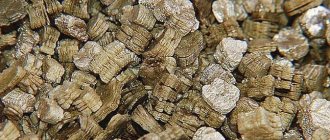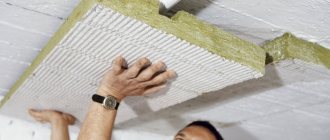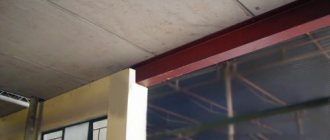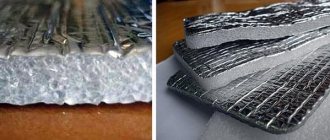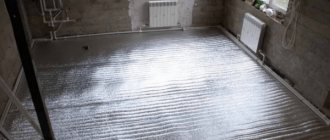Why is thermal insulation necessary?
Thermal insulation of a frame pool in a country house or country house is especially important if the structure is buried in the ground.
Typically, the depth is up to 2 m. It must be taken into account that even in the hottest period, the soil temperature at such a depth is not higher than +11° C.
The temperature difference between the surface of the frame at night and during the day can reach 10°C . This affects both heating and heat retention in the lower part of the structure. First of all, the wear-resistant qualities of the frame deteriorate.
Even if on a hot day the top layer quickly heats up under the sun's rays, the water will also cool down quickly due to the cooled lower part of the pool.
If you plan to cool the water less quickly and to enjoy swimming longer, it is recommended to lay a layer of insulation.
Features of care
To maintain the vinyl ceiling in its original appearance and extend the life of the coating, you will need to follow the following maintenance rules:
- wipe the ceiling every two months;
- If deformation is detected, immediately call a qualified technician;
- if damaged by sharp objects, seal it until a specialist arrives so that the cut does not increase;
- For wiping, use only a soft cloth (brushes and sponges can damage the material).
Glossy ceilings are treated with window cleaner or a solution of water and ammonia (ratio 1:10). To prevent streaks from forming, you need to wipe in a straight line.
Matte ceilings can be washed with a soap solution made from laundry soap. It is also possible to use diluted ammonia. After this, be sure to wipe the canvas dry with a soft cloth.
Satin polyvinyl chloride ceilings can only be cleaned dry using a cotton napkin. And in case of severe contamination, the use of a special alcohol-based polish is allowed.
Cleaning the surface of the PVC sheet should be done effortlessly, otherwise there is a risk of damaging the material. When washing a welded ceiling, you must move parallel to the seams. It is better to remove stains and dirt immediately after detection. Before using any product, it is recommended to test it on a small area. And if renovation work is planned in the room, then the ceiling should be covered with film or temporarily dismantled.
Basic rules of insulation
Before you begin insulating a frame pool, you need to take into account the nuances of the procedure:
- The surface on which the structure is installed must be either cemented or with tightly compacted soil.
- The insulation procedure is carried out when installing the structure in a permanent place. The sides of the pool can be insulated later.
- Lay the insulation material so that the number of joints is minimal. If there are any, seal them.
Installation principle
Installation takes 3-4 hours. But before installing a suspended ceiling in a pool, it is necessary to prepare the room. All cracks must be sealed, the surface leveled and free access to the walls organized. Also, before installation begins, electrical wiring, utility networks and ventilation are arranged.
An aluminum profile or plastic baguette is used to attach the film, and baseboards and other decorative linings are used to mask the gaps between the wall and the canvas.
Installation of PVC ceilings is carried out using the harpoon fastening method. A harpoon is a film edging welded to the canvas in production. It looks like a hook that snaps and locks into the mounting profile. Then the decorative plinth completely covers the gap between the wall and the ceiling. This fastening allows you to repeatedly dismantle and reinstall the ceiling without damaging the canvas.
The installation process itself consists of the following steps:
- Fastening the baguette along the perimeter of the ceiling or on the surface of the walls using impact and plastic dowels.
- Unfold the fabric and gradually heat it to straighten the folds.
- Fastening the canvas to the baguette using clips.
- Stretching the material diagonally and heating it with a heat gun to 70°C.
- Fastening the remaining corners and sides of the canvas.
- Installation of thermal rings under lighting fixtures, which protect the PVC film from deformation. Installation of lamps.
- Cooling the canvas to room temperature so that the coating straightens and acquires the necessary tension.
Recessed or non-recessed tank
To properly insulate an in-ground pool, it must be properly deepened.
To do this you need:
- Measure the perimeter of the pool and dig a pit that will be 1 m wider than the perimeter. The depth of the pit should be no more than 2/3 of the height of the frame pool.
- Make sure that the soil or sand at the bottom of the pit is thoroughly compacted. The best option would be to concrete the surface. Before laying the insulation, make sure that the pit is perfectly level.
Only after such measures have been carried out can you proceed to the procedure for insulating the pool structure. If the pool is buried in the ground, it is additionally recommended to insulate not only the bottom, but also the sides of the pit.
How to choose material?
When choosing a material, you need to take into account that it must meet certain requirements:
- Perform not only heat-insulating, but also waterproof function.
- Withstand high loads (including being resistant to mechanical damage and withstanding low temperatures in winter).
- A good effect will be achieved by using a material that leaves a minimum number of seams and places for cold penetration.
The best options for insulation would be the following materials:
- Styrofoam;
- thermal insulation membranes;
- sprayed polyurethane foam.
It is not recommended to use materials as insulation that can damage the structure or those where there are many joints left after installation.
What else can you make a pool ceiling from?
In addition to tension structures, when arranging ceilings in an indoor pool, you can also use the following options:
- waterproof paint;
- suspended metal structures;
- mirror panels;
- glass ceilings with lighting.
Waterproof paints are usually used for small swimming pools. They are easy to apply and resistant to moisture. Used in combination with an antiseptic primer. Among the disadvantages, it is worth noting the formation of condensation, which will shorten the life of the coating, as well as the inability to hide communications and make an interesting design.
For suspended metal structures, aluminum and steel slats are used. They are lightweight and characterized by strength, reliability, durability, and the ability to choose different textures and colors. Such metals do not burn and are resistant to corrosion and moisture. Slatted ceilings are often used in private homes when arranging small bathrooms.
Mirror designs in the pool look very elegant and stylish, they allow you to visually expand the room, add light and volume. The most popular option for such ceilings is faceted edges without gaps, which reflect light from each other. With the help of mirrored ceilings it is possible to realize the most original ideas. They are environmentally friendly, moisture resistant and meet all safety requirements.
Glass ceilings in combination with lighting fixtures allow you to create original light and spatial effects and embody the most daring design ideas. They give the room volume and airiness and are easily combined with other materials.
But all of the above options have many disadvantages. Thus, metal structures will not save you from condensation and will not create an atmosphere of comfort. And waterproof paints will quickly become unusable due to constant humidity and temperature changes. Unlike suspended ceilings, which completely eliminate such difficulties, these materials will create problems that need to be solved. Thus, suspended ceilings made of PVC film are an ideal option for finishing swimming pools.
How to insulate: step-by-step instructions
Several material options can be used as insulation for a frame pool. The specifics of insulation depend on the material used and whether the frame will be buried in the ground or not.
Foam plastic
This material is best used for insulating pools of the correct shape - without bends or surfaces of non-standard shapes. Polystyrene foam is one of the most popular materials for insulating not only swimming pools, but also foundations. It is considered a mechanically strong product that can withstand even minimal ground displacements.
Stages:
- Clearly mark the contours of the place where the pool will be located (if it is not buried). It is desirable that the sand or soil underneath is not loose.
- Place a backing in the place where the pool structure will stand. If its edges protrude slightly beyond the contour, it is better to bend the material inward. It is not recommended to trim such edges.
- Lay out sheets of foam plastic. Make sure that the edges also match the contour of the pool area. The sheets should fit tightly to each other. It is better to trim off excess edges with a stationery knife.
- After laying the material, glue all foam plastic seams so that there are no gaps and they are immovable.
The surface is ready for installation of the pool structure.
It should be taken into account that the foam insulation layer may sag a little over time.
Roll material
To carry out the insulation procedure, you need to follow the rules:
If the perimeter where the structure will stand is not concreted, you need to pour a layer of sand (or dig the soil 2 bayonets deep) and compact it thoroughly.
It is advisable to water the surface again, compact it and level it. To avoid shrinkage, such activities should be carried out over 2-3 days - the soil should be well compacted before laying the insulation and installing the pool.- Place roll insulation on top. Do this so that there are no gaps or waves on the surface. After thorough installation, all joints should be covered with a special tape for sealing. The insulation must be placed under the entire surface of the structure.
- Additionally, roll insulation can be used as a lining on the sides, especially if the pool has a recessed design.
Underlay under laminate or old linoleum
Such material will not only maintain a comfortable water temperature (serves as a heat insulator for the bowl), but will also preserve the appearance of the surface. When choosing the amount of substrate, be sure to focus on the area of the pool bottom and its shape.
Features of laying the substrate or old linoleum depend on whether the pool will be buried or not:
- If the structure will simply stand on the ground, then you first need to outline the dimensions of the bottom and cover it with a layer of sand or soil. It is better to add them several times, giving each time time for shrinkage of 2-3 days. After this, the outlined area is covered with a substrate (if desired and financially possible, two layers can be laid).
- If the structure is deepened into the ground, the bottom of the pit is carefully leveled with sand or soil, followed by shrinkage of the material over several days. When installing an in-ground pool, the best option would be to concrete the surface. In this case, the substrate can be laid not only on the bottom of the pit, but also used as a gasket on the sides of the frame structure. It can serve as insulation and protect the sides from damage.
Wooden flooring
- When installing boards, you must maintain a distance of 50 cm. Place supports every 75 cm.
- If wood flooring is laid on concrete, it is better to take care of waterproofing.
- Calculate the dimensions of the bottom of the frame and the dimensions of the boards so that the latter protrude no more than 25 cm under the pool. Before laying the boards, it is advisable to treat them with an antiseptic.
When laying any type of insulation, it is recommended to lay an additional substrate underneath in the form of linoleum, polyethylene or thick tarpaulin.
Advantages of suspended ceilings for a swimming pool
Let's see why a suspended ceiling is the best choice for a swimming pool. Let's consider what qualities the material should have.
It takes a lot of time and effort to do regular antifungal treatments. A PVC ceiling will eliminate this problem, since the canvas undergoes antibacterial treatment.
Ceilings made of plastic or metal with a special anti-corrosion coating are also resistant to high humidity, but they will not save you from condensation. That is, problems arising from dampness will not go away. In addition, such materials look less aesthetically pleasing than film.
Waterproof paint will also not solve the problem, since due to constant humidity, the coating will need to be renewed after a short period of time. And stretch ceilings will retain their original appearance for many years.
So, let’s list the advantages of a stretch ceiling that make it an ideal finishing material for a pool:
- No condensation. It does not form on canvases made of polyvinyl chloride. Condensation occurs when there is a large difference between the cold finishing material and the warm air. After the temperature drops, the water drops disappear. Since the thickness of the PVC film for the ceiling is minimal (0.16-0.2 mm), the canvas quickly warms up when the air temperature rises, and cools down when the air temperature decreases. Thus, the formation of condensation on film stretch ceilings is, in principle, impossible.
- No mold or mildew. Polyvinyl chloride film has a perfectly flat surface with an antibacterial effect, so there is no environment for the development of mold and fungi.
- Flood protection. PVC ceilings do not allow moisture to pass through and are highly durable and elastic. Vinyl film can withstand several hundred liters of water. Of course, if the pool itself is flooded, nothing bad will happen. But if the flood touches the locker rooms, rest rooms and other premises, the property and decoration will be greatly damaged. Therefore, suspended ceilings, which eliminate this possibility, are the best solution for all areas of the pool. In case of flooding, the water from the inter-ceiling space is drained, the surface is dried and tensioned again.
- Long service life. Stretch ceilings, despite dampness, do not lose their quality and original appearance, and last more than 15 years.
